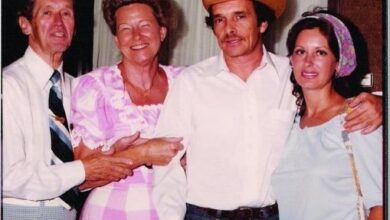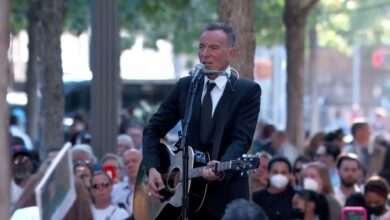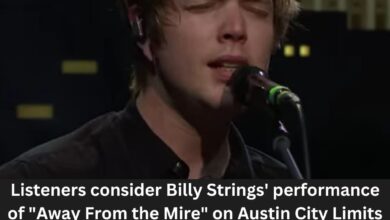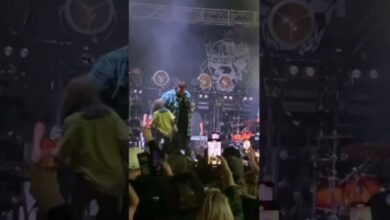Barry Gibb and son Stephen moved fans to tears with a touching tribute to Robin and Maurice on tour
In 2013, Barry Gibb embarked on his inaugural solo tour, the “Mythology Tour,” marking a significant milestone in his illustrious career. This tour was not only a celebration of the Bee Gees’ extensive musical legacy but also a heartfelt homage to his late brothers and bandmates, Robin and Maurice Gibb. The performances resonated deeply with fans, evoking a spectrum of emotions as Barry took the stage without his siblings for the first time.
A particularly moving segment of the tour featured Barry’s son, Stephen Gibb, joining him on stage for a duet of the 1968 Bee Gees classic, “I’ve Gotta Get a Message to You.” This collaboration was more than a musical performance; it symbolized the passing of the torch and underscored the enduring bond of the Gibb family. Stephen’s rich, resonant vocals complemented his father’s, creating a harmonious blend that captivated audiences. The father-son duo’s rendition was imbued with raw emotion, reflecting their shared grief and love for Robin and Maurice.
The choice of “I’ve Gotta Get a Message to You” was particularly significant. The song, originally penned by the Bee Gees, tells the story of a man awaiting execution, yearning to send a final message to his loved one. Its themes of urgency, remorse, and redemption mirrored the sentiments Barry wished to convey during the tour. By revisiting this classic, Barry not only honored the Bee Gees’ musical contributions but also underscored the personal losses he endured.
Stephen Gibb’s involvement in the tour added a contemporary dimension to the performances. An accomplished musician in his own right, Stephen brought his unique style and energy to the stage. His collaborations with his father during the tour served as a bridge between generations, blending the timeless appeal of the Bee Gees’ music with modern interpretations. This fusion was well-received by audiences, who appreciated the fresh take on beloved classics.
The “Mythology Tour” was meticulously crafted to pay tribute to the Gibb brothers’ legacy. Barry incorporated multimedia elements, including archival footage and photographs of Robin and Maurice, creating an immersive experience that transported fans through the Bee Gees’ storied history. These visual components, combined with live performances, evoked nostalgia and reverence, allowing audiences to relive cherished memories while honoring the band’s evolution.
Throughout the tour, Barry’s interactions with the audience were heartfelt and intimate. He often shared personal anecdotes and reflections about his brothers, providing insight into their familial bond and the dynamics that shaped their music. These narratives added depth to the performances, fostering a deeper connection between Barry and his fans. The candidness with which he spoke about his loss and love for Robin and Maurice resonated with many, making the concerts more than just musical events—they became communal experiences of remembrance and celebration.
The tour’s setlist was a carefully curated blend of the Bee Gees’ greatest hits and lesser-known gems. Songs like “To Love Somebody,” “How Deep Is Your Love,” and “Stayin’ Alive” were interspersed with tracks that held personal significance to Barry and his family. This selection not only showcased the breadth of the Bee Gees’ catalog but also highlighted the emotional journey Barry intended to take his audience on. Each song choice was a thread in the tapestry of the Gibb family’s musical narrative.
Critics and fans alike lauded the “Mythology Tour” for its emotional depth and musical excellence. Reviews highlighted Barry’s enduring vocal prowess and stage presence, noting that, even without his brothers, he commanded the stage with grace and passion. The addition of Stephen and other family members to the lineup was praised for adding authenticity and warmth to the performances. The tour was seen as a fitting tribute to the Bee Gees’ legacy, honoring the past while embracing the future.
Beyond the music, the tour had a therapeutic aspect for Barry. In interviews, he expressed how performing helped him cope with the grief of losing his brothers. The stage became a space for healing, allowing him to channel his emotions into his art. This cathartic process was palpable to audiences, who felt the sincerity and vulnerability in his performances. The shared experience of mourning and celebration created a unique bond between Barry and his fans during the tour.
The “Mythology Tour” also served to introduce the Bee Gees’ music to a new generation. Younger attendees, perhaps less familiar with the band’s extensive catalog, were given a comprehensive overview of their contributions to music history. Barry’s storytelling and the multimedia presentations provided context, making the music accessible and relevant. This educational component ensured that the Bee Gees’ legacy would continue to resonate with audiences of all ages.
Incorporating family into the tour extended beyond Stephen’s participation. Barry’s niece, Samantha Gibb, daughter of Maurice, also joined the ensemble, further emphasizing the familial theme. Her presence added another layer of authenticity and continuity, symbolizing the ongoing influence of the Gibb lineage in the music industry. The collaboration of multiple generations on stage highlighted the enduring nature of the family’s musical talent.
The tour’s production values were meticulously planned to enhance the emotional impact of the performances. Lighting, stage design, and visual effects were all employed to create an atmosphere that complemented the music’s mood. These elements worked in harmony to evoke the desired emotional responses, whether it be joy during upbeat numbers or introspection during ballads. The attention to detail in the production underscored the tour’s significance as a tribute to the Bee Gees’ legacy.
Audience reactions were overwhelmingly positive, with many attendees expressing profound emotional experiences. Fans recounted moments of tears and laughter, noting how the performances stirred memories and feelings associated with the Bee Gees’ music. The communal aspect of the concerts helped foster a shared connection among attendees, turning each show into a moving tribute to the enduring power of music and family.



